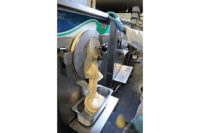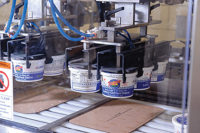There are those in the dairy industry who do their work at a desk. Others work in a manufacturing plant, far from prying eyes. Then there is a third group: those who are on full public display, their every move scrutinized by wide-eyed visitors who are curious about how food is made.
The men and women who make ice cream for Velvet Ice Cream Co. in Utica, Ohio, are part of this third group. Only a sheet of glass separates their work space from a viewing gallery where thousands of children, parents and grandparents watch and learn how ice cream is made.
The ice cream plant is a key element in the marketing program of the Dager family, whose 100-year-old business is located in the rolling farm country 40 miles east of Columbus. Appropriately, for a maker of ice cream, the company is headquartered in Licking County.
Long before the term “agri-tourism” was coined, the second and third generations of the Dager family were welcoming visitors to company headquarters, which includes the plant, a restaurant, a gift shop and picnic grounds. Today, three sisters (representing the fourth generation) lead the company, having taken over the reins from their father, Joseph C. Dager (who is still active in the business as chairman of the board). See related article.
The plant produces all of the company’s ice cream, sherbet, sandwiches and push-ups. (Stick novelties are co-packed by another manufacturer.) If you think a 100-year-old company has done it all, think again. It is not sitting back and resting on past successes. Velvet is constantly developing new flavors and flavor combinations with the help of its suppliers, customers and consumers. New products typically hit retail shelves in March and April. Just this year alone, Velvet rolled out a 100% natural line (in honor of its centennial), and blueberry sweet corn ice cream for the Ohio State Fair.
The company uses a lot of flavorings, nuts, fruits, ribbons and inclusions. A popular flavor is Buckeye Classic, made with peanut butter ice cream, chocolate fudge swirls and chocolate-covered peanut butter candies. Other flavors include Raspberry Fudge Cordial (black raspberry ice cream swirled with fudge and raspberry cordials), Turtle Trails (Original vanilla ice cream with chocolate-covered caramel cups, butter pecans and caramel sauce), Butter Pecan Cashew and a new flavor, Honey Caramel. On a take-off of Neapolitan, Velvet combines three distinctly flavored vanilla products into one package: Original, Olde Time and Vanilla Bean. Seasonal offerings include Peach Cobbler and Pumpkin Pie.
Velvet Ice Cream built its reputation on making premium products that adhere to the standard of identity for ice cream. Its lines consist of premium, all natural, churned (low-fat), no sugar added, novelties, sherbet (in cups and in push-up tubes) and a controlled ice cream brand for grocery store customers.
“Premium is not a fad,” Joe Dager said. “People want something good. We have a reputation for higher prices. That’s not bad.” He said that when customers know how Velvet makes ice cream and the ingredients it uses, they understand the price.
The production process
Plant Manager Ken Harold led Dairy Foods on a tour of the 60,000-square-foot plant this summer. Velvet Ice Cream receives one tanker of cream in a normal week. In the summer, when production increases, two tankers arrive every week. Farms from Ohio, Michigan and Indiana supply the cream, which is stored in two pasteurized tanks until it is needed. There is one 5,200-gallon sucrose tank outside the plant and one 5,000-gallon tank inside.
The processing room has two 600-gallon batch tanks. A blender hydrates the milk powders and other dry ingredients used in the ice cream mix. Then cream and sugar are added to the mix. It is run through a homogenizer (with a capacity of 2,000 gallons per hour) and then the high-temperature short time pasteurizer (1,000 gallons per hour). The mix is held in as many as five holding tanks, depending on the production schedule.
From April 1 to Sept. 1, Velvet runs three production lines and cuts that back to two lines in the autumn and winter months. In one corner of the packaging room, an employee operates a forming machine to make 56-ounce cartons. Packaging for the premium ice cream products recently decreased to 56 ounces from 64 ounces, Joe Dager said.
At the heart of the production operation is a versatile freezer bought three years ago. One freezer fills 56-ounce squares or rounds (depending upon the customer) and it can also fill pints. Nuts, fruits and candies are added from a fruit filler. After filling, the packages are collated into bundles of four or six and conveyed to the hardening room. Velvet Ice Cream also has a bulk filler for 3-gallon foodservice containers. Another machine, which makes ice cream sandwiches and fills 4-ounce cups, is on casters so it can be wheeled out of the way when it is not needed.
Making ice cream is part science and part art. Even though a dairy processor follows a recipe exactly, the flavor can vary. That is one reason Harold said he encourages employees to taste the mix at any time during a production run, but especially at start-up, which is the best time to correct any mistakes. By tasting the mix every day, employees learn to recognize what the ice cream is supposed to taste like. Then they can make adjustments that result in a consistent product, run after run.
Food safety
A small on-site lab is headed by Quality Assurance Manager Dan Dickson. Lab personnel are also cross-trained to perform other jobs in the plant. The lab runs tests on butterfat and other components, and holds a sensory evaluation every day. In-process product is sampled daily. Product is held for a year to test for shelf life.
The lab also conducts daily microbial tests for coliform and standard plant count. Daily adenosine triphosphate (ATP) assays test for food, bacterial and biofilm contamination on equipment and surfaces. A weekly environmental swabbing throughout the plant (with attention given to conveyors, drains, walls and floors) assures that the production areas are clean. The swabs are sent to an outside agency for evaluation. The Ohio Department of Agriculture inspects the plant twice a year. The federal Food and Drug Administration also has jurisdiction over the plant.
A safety committee meets bi-monthly to identify issues and to train employees on procedures and practices. The company’s HAACP program, introduced in 2000, is revised constantly as new food safety standards are unveiled and best practices are learned.
Velvet Ice Cream takes a comprehensive approach to approving suppliers. Selecting a supplier usually starts with a good reference from another manufacturer or supplier, Dager said. Suppliers need to demonstrate that they have their own HAACP plan and that it has been audited by a third party.
Velvet Ice Cream has come a long way since the founder started churning ice cream in his brother-in-law’s basement 100 years ago. To continue to thrive in its second century as a family-owned business, the owners will be investing in the plant. It is considering adding a higher-capacity pasteurization system that would increase throughput from 1,000 gallons per hour to 1,500 gph.
The company also needs more freezer space, Dager said. And, in fact, plans are underway to add capacity at the plant. Velvet Ice Cream also has cold storage at its seven distributions centers in Ohio and Kentucky (its newest location). Besides storing its own products, Velvet warehouses frozen and refrigerated foods for “partner brands,” the company’s term for the products it delivers on its 40 DSD routes throughout Ohio, Indiana, West Virginia and Kentucky. These products include ice cream and ice cream novelties.
While company drivers are traveling to their customers, thousands of consumers are driving to Utica for a first-hand look at how ice cream is made. Plant Manager Harold said the employees like the attention. They’ll often look up from their work stations and wave or nod to the children on the other side of the glass window. It’s not listed on the package, but “friendliness” is certainly an ingredient that contributes to the long-time success of Velvet Ice Cream Co.
At-A-Glance
Velvet Ice Cream Co., Utica, Ohio
Products made: 173 SKUs, including premium ice cream, no sugar-added ice cream, sandwiches, and cups
Age of plant: Built in 1961
Size of plant: 60,000 square feet
Pasteurization: One 1,500 gallon per hour HTST pasteurizer; two 600-gallon batch tanks
Filling lines: Three, with processing capacity of 30,000 gallons per day
Fillers: 10, capable of filling 3-, 4-, and 12-ounce cups, pints, quarts, half-gallon round and square containers, 2.5- and 3-gallon bulk containers, ice cream sandwiches and push treats.
Pasteurized tanks: Seven refrigerated stainless steel-lined tanks with total capacity of 30,000 gallons.
Sweetener tanks: Two. 5,200 gallons for sucrose; 6,000 gallons for corn syrup
Warehouse: 20,000 square feet
Shifts: One
Production employees: 18
Photos by Vito Palmisano










